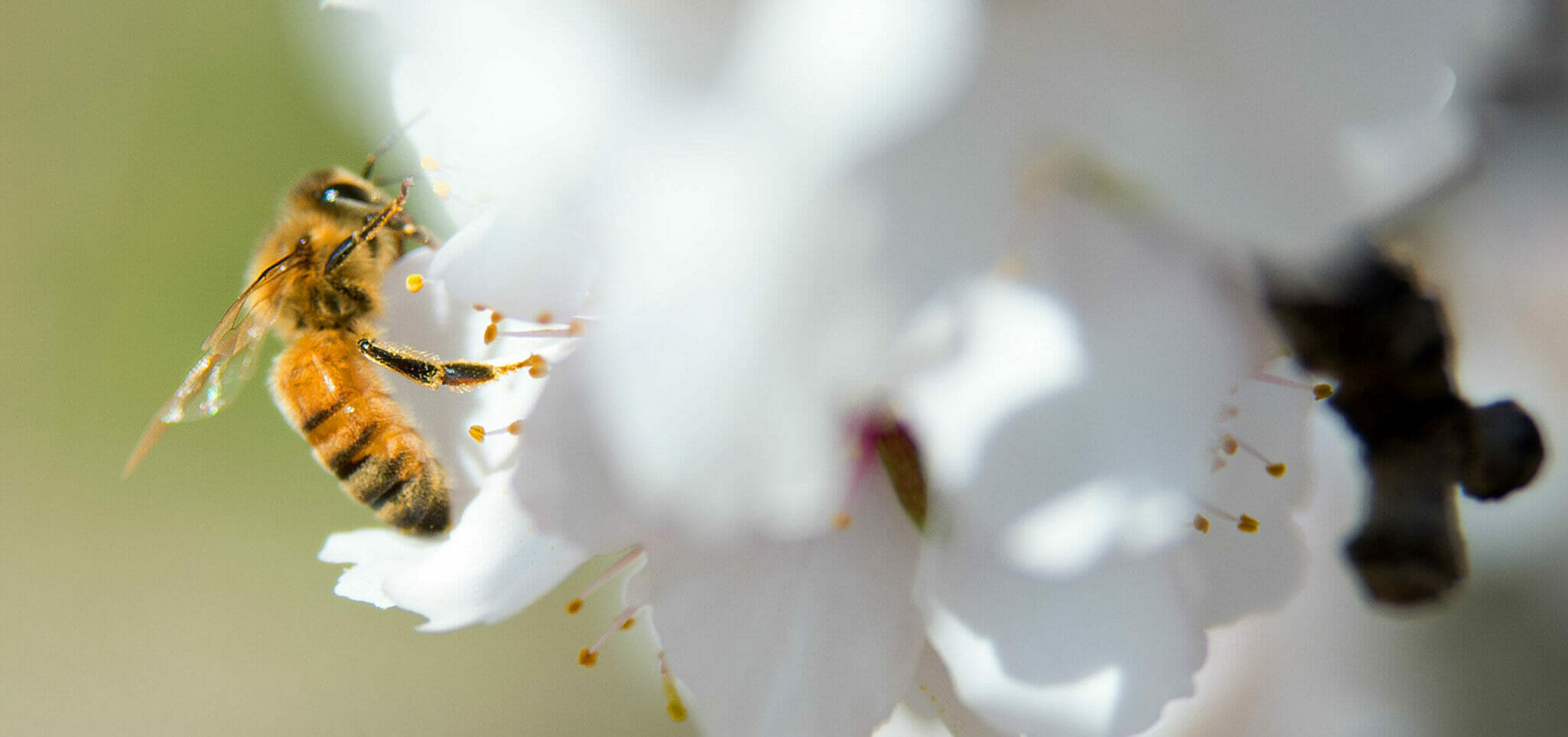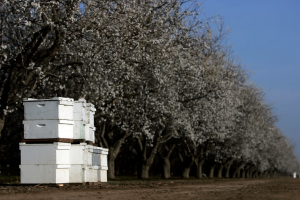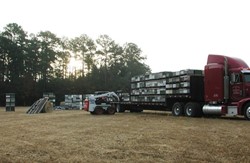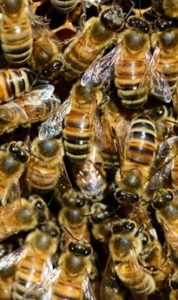Problematic Production
Our Planet’s Buzziest Worker
Shaun Grega

The world’s growing population is proving that we require not only more food than ever, but diverse, balanced, and healthy diets to ensure the health and well-being of humankind. Let there be almonds, a nut low in carbohydrates and high in monosaturated fats and proteins. It is likely you have heard of or seen the wonderful benefits of almonds and even more likely of having consumed the marvelous nut. Consumers in the United States, and around the world, have grown fond of the nutritional benefits and versatility of almonds; spawning diet fads and products like almond milk and almond bars. Although the rising craze for almonds has seen backing in the financial sector and in marketing campaigns, there is a stronger, elusive force integral to almonds’ rise to fame: the honeybee.
Honeybees are renowned for their production of several foods and products like honey and beeswax, but their pollination skills are instrumental in the development and maintenance of our food supply. In fact, almond trees rely almost exclusively on the honeybee’s pollination, emphasizing the invaluable ecological services of the honeybee. Although integral in the United States’ growing agricultural industry and crop viability, billions of bees are decimated each year, affecting all levels of the bee supply chain from beekeepers all the way to consumers. The simple truth is, without honeybees, many of the ingredients, foods, and snacks we consume daily will vanish accompanying the honeybee.

Because of their essential role in the agricultural output of the United States, the United States Department of Agriculture classifies bees as livestock. Due to the agricultural industry’s increasing demand and reliance on honeybee populations, commercial beekeepers have turned to the lucrative practice of moving and renting bee colonies to farms and orchards all across the country. Beekeeping has become an essential element of industrialized agriculture in the United States for all crops requiring pollination. In return for ensuring pollination success on commercial cultivations, beekeepers earn rental fees, strengthen their hives, and generate honey to be sold (Armstrong, 2020). While providing plentiful resources for the development of hives through orchards and farms, beekeepers continue to struggle to maintain their colonies’ populations, resulting in an annual loss of 30% in commercial bee populations. It is important to note that my focus in the succeeding paragraphs serves to highlight the impacts on honeybee populations as they relate to human experiences; with almonds an exemplary culprit but not the sole cause and result.
Why are pollinators declining?
A third of a loss to any workforce would be debilitating. However, beekeepers have learned to accept these losses as regularities in their craft and are attempting to discover the susceptibilities of their hives to bee loss. There are several factors, almost all related to the worsening climate crisis, diminishing the health, strength, and numbers of beehives including transportation, lack of crop biodiversity, and pesticide and fungicide use.

Spring comes early in California, usually in early February with almond groves the first to blossom in arrays of white petals. As the demand for crops increases, growers are forced to harvest earlier in order to maximize yields throughout the harvesting season. As a result, pollination must occur as soon as crops begin flowering. Commercial beekeepers take advantage of varying bloom periods of different crops by transporting truckloads of thousands of hives across the country. Some crop flowering periods are short-lived, lasting for only around two to three weeks. Therefore, growers have a narrow window to provide intensive pollination. Once beehives are transported across the country to be ready for this short window, hives are forced out of their natural dormancy to tirelessly pollinate farms and orchards. These early, short pollination windows, combined with the increasing demand that influences farmers to harvest early, put tremendous stress on bee health and their viability. Subjecting bees to varying climates and habitats increases stress and leads to decreased immune function and defense responses (Says, 2019).
Transportation itself poses significant risks by subjecting bees to varying climates and confining bees to their hives. Bees have the unique ability of thermoregulating hive temperatures through coordinated efforts – deviations from a five-degree range can be deadly. However, during transportation periods, many bees suffocate as they lose their ability to regulate the temperature of their hives. While in confined hives during transportation, fungal parasites and viral pathogens, nosema and the varroa mite respectively, pose survival risks that persist even once the hives have been established. Beekeepers throughout the United States highlight the effects of viruses and mites. According to small scale beekeeper Steve Grega, “Mites are my number one concern. Last year I lost three out of eight hives. Our club members averaged over 50% [of hive loss].” Viral mites feed on honeybee larvae and spread through hives by hitching rides on adult bees while fungal parasites disrupt and weaken a bee’s digestive system (Mewright, 2016).
Bees coevolved with flowers in their native habitats so that their sizes and behaviors complement their native habitat’s pollination cycle. However, farms and orchards are usually monocultures, cultivations of a single crop that have little to no biodiversity. Bees thrive in biodiverse landscapes. Varieties of crops and wildflowers that are native to the bee’s habitat are beneficial for a bee’s metabolic consumption. As wilderness areas are turned into large scale farms, biodiverse landscapes are depleted. Consequently, habitat loss is making it harder for bees to find shelter and food.

Colony Collapse Disorder poses the greatest risk to honeybee populations. This phenomenon occurs when a majority of worker bees leave behind the remaining queen, immature bees, and abundant reserves of honey and pollen. The causes of Colony Collapse Disorder are not certain, however, there is evidence to suggest the use of toxic pesticides and fungicides are culprits. A specific pesticide, neonicotinoids, are being looked at for their disruption of hive activity and interference with the ability of bees to navigate back to their hives. Several other pesticides are found in soil, foliage, and within seeds to limit pests but ultimately attach to bees and concentrate into a ‘pesticide cocktail’ within hives. Even if cultivations with honeybees stop the use of pesticides, bees can travel several miles away from their hive to other cultivations that choose to use them, exposing them to pesticides (Grossman, 2013). Despite these factors, the honeybee will continue to do its job while farmers continue to attempt to exploit these winged creature’s work as the demand for these crops increases.
But we need them more than ever…
Let us examine the increase in demand for crops requiring pollination and hence leading to the decline of honeybee populations. The increasing demand of the international agricultural industry is creating an immense strain on honeybee populations and their ability to pollinate. Within the last fifty years, the number of crops requiring pollination has tripled. The rise in the demand for almonds and similar specialty crops can be attributed to consumer desire for environmentally low-impact, healthier, and plant-based food alternatives. Given the heavy footprint of rearing livestock and its agricultural demands, many people are looking for alternative sources of protein through plant-based diets. New technologies, techniques, and marketing are accelerating this growth in demand as well. As the demand for crops increase, more land is being devoted to cultivation, additional pesticides are being used, and a greater number of honeybees are required to pollinate.
Take almonds as an example. Almond milk has grown in popularity and touted as a healthier alternative to regular dairy milk that, in addition, minimizes environmental harm and does not inhumanely corral cattle. Ironically, the exploitation of cattle has shifted to bees. Plant-based diets and the incredible versatility of almonds in foods such as almond milk, butter, and flour, has spurred California farmers to increase their almond outputs and harvest earlier, emphasizing the need for honeybees and threatening more pollinators.
Likewise, greater international demand in the European Union, India, and China have led to greater exports from the United States for specialty crops. For instance, California’s almond industry churns out around 80% of the world’s almonds, an industry valued over $11 billion, necessitating the honeybee’s powerful and efficient pollination. International demand has promoted the industry, leading California to export 70% of their almond crop with China as the leading customer. As a result, almonds landed themselves as the leading specialty crop export in the United States (Philpott, 2015). While honeybees continue to be undervalued as ecological proponents of an entire international industry, their loss pose significant risks to the bottom-line and all consumers.
Consumer Implications
The declining health of honeybee populations comes with major implications in food security and variety for consumers. Honeybees are responsible for $24 billion in US annual agricultural revenue but their contribution to nutritional variety and biodiversity is priceless.Honeybees are responsible for $24 billion in US annual agricultural revenue but their contribution to nutritional variety and biodiversity are priceless. As greater demands are placed on the honeybee, their loss will cause alterations in our food availability. Pollination prices have increased by 300% since 2000, becoming one of the most expensive inputs in crop production (Schwartz, Kuenzle, Pinsky, 2014). Likewise, as more input is required through pollination, there will be greater economic costs to grow these crops that ultimately pass down to consumers (Ferrier, 2018).
More indirect are the shortages in other commodities, like livestock, that we would expect to see with declining bee populations. Many animal species also rely on the power of pollination to receive their diet. Alfalfa, for example, is cultivated as a forage crop for grazing and hay for livestock and relies on pollination to reproduce. Without this source of food, livestock populations will decline and inevitably cost more for consumers. However, there is still hope as companies and farmers have altered practices and techniques to make for more sustainable honeybee habitats.
Protecting Bees and Safeguarding Food Security
There are several sensible actions that can help restore and protect the world’s bees: banning the use of the known bee-toxic pesticides, preserving wild bee habitats, and maintaining ecological-friendly agriculture practices. Similar to organic and fair-trade labels, companies, farms, and orchards are creating ‘Bee Better’ programs, farms, and labels that allow consumers to choose products that have been made with bee-friendly and eco-friendly methods.

These programs promote the biodiversity of groves and farms with native flowering hedges that naturally control pests and nourish honeybees as well as limit the bee’s susceptibility to pesticides. Häagen-Dazs began labeling their products, from ice cream to nutrition bars, to promote awareness of the flavors and ingredients that are bee-dependent while also planting wildflowers to foster greater biodiversity in their suppliers’ groves.
Beekeepers have also adapted their practices, publishing best practices for growers, accounting for fluctuations of bee populations, to minimize hive loss, and allow quick reactions when disruptions do occur. However, although commercial beekeepers are able to account for environmental and biological shocks, data is sparse on non-managed hives that are completely natural and that are as likely to be at risk. The Bee Corp is an Indianapolis based firm aiming to help beekeepers and farmers to assess the strength of their hives through infrared technology. Allowing farmers the ability to monitor data on hives increases pollination and protects yields. Helping growers understand a fundamental input in crop yields, The Bee Corp reduces strain on bees and beekeepers during major pollination events. While there are numerous contributing factors at play affecting beehive health, beekeepers can then spend less money and time to prepare their hives for pollination to stay profitable (The Bee Corp, n.d.).
Honeybees are vital indicators in the balance of biodiversity and the state of the environment; they represent the cohabitation of nature and industry. Honeybees are vital indicators in the balance of biodiversity and the state of the environment; they represent the cohabitation of nature and industry. Their presence and absence are clear indicators of the state of the environment. The challenges facing the honeybee are complex and evolving and have a profound impact on our daily lives. Clearly, the current casualties of bees are unsustainable in the long run. Although humans will likely outlive the existence of honeybees, our diets will tremendously suffer as other livestock and crop yields decrease. Almonds and other crops will become expensive, rare, or extinct. If these annual trends in bee loss continue, we will jeopardize much of the food chain, rippling to not only humans but other ecosystems that are also reliant on the bee’s work. Of the one hundred crop species that feed 90% of humanity, over seventy species are directly pollinated by bees (BBC, 2014). Farms and companies that are reliably giving attention to the honeybee’s health will produce and maintain efficient hives and happy bees as the demand for the byproducts of their work increases. Despite our progress in improving and maintaining honeybee populations, there are still efforts to undertake to ensure every bee’s health.
References
Almond Growers: The Bee Corp: United States. (n.d.). Retrieved December 10, 2020, from https://www.thebeecorp.com/
Armstrong, L. (n.d.). California’s almond trade is exploiting one of nature’s most essential workers. Retrieved December 01, 2020, from http://www.ifis.org/blog/californias-almond-trade-exploiting-bee-population
Elizabeth Grossman is the author of Chasing Molecules: Poisonous Products, Grossman →, M., Pearce, F., Pearce, F., Oldham, J., Oldham, J., . . . Hurowitz, G. (n.d.). Declining Bee Populations Pose a Threat to Global Agriculture. Retrieved December 01, 2020, from https://e360.yale.edu/features/declining_bee_populations_pose_a_threat_to_global_agriculture
Entomology Today, Says:, R., & Says:, D. (2019, April 01). Road Trip: How Hive Transportation Puts Stress on Honey Bees. Retrieved December 01, 2020, from https://entomologytoday.org/2019/04/01/road-trip-hive-transportation-stress-honey-bees/
Mewright. (2016, April 26). First Multi-year Study of Honey Bee Parasites and Disease Reveals Troubling Trends. Retrieved December 01, 2020, from https://cmns.umd.edu/news-events/features/3515
Peyton Ferrier, R. (n.d.). Economic Effects and Responses to Changes in Honey Bee Health. Retrieved December 01, 2020, from http://www.ers.usda.gov/publications/pub-details/?pubid=88116
Philpott, T. (2015, January 15). What America’s nutty demand for almonds is doing to California. Retrieved December 01, 2020, from https://grist.org/food/what-americas-nutty-demand-for-almonds-is-doing-to-california/
Schwartz, J., Kuenzle, M., & Pinsky, D. (2014, June 18). Save the Bees. Retrieved December 01, 2020, from http://www.greenpeace.org/usa/sustainable-agriculture/save-the-bees/
What would happen if bees went extinct? (n.d.). Retrieved December 01, 2020, from http://www.bbc.com/future/article/20140502-what-if-bees-went-extinct
